Conroe Buying Guide: Feeding the Monster
by Gary Key & Wesley Fink on July 19, 2006 6:20 AM EST- Posted in
- Motherboards
Standard Gaming Performance
We tested with a small group of games due to time constraints, but we picked games based on a variety of game engines to give a quick indication of the boards' performance. Additional testing will be done in our full board reviews but for this roundup we are using Serious Sam 2, Half Life 2: Lost Coast, F.E.A.R, Quake 4, and Battlefield 2. All boards were tested with the EVGA 7900GTX using NVIDIA 91.31 WHQL drivers. The Intel 975X boards were also tested with a single ATI X1900XTX card with the Catalyst 6.6 driver.
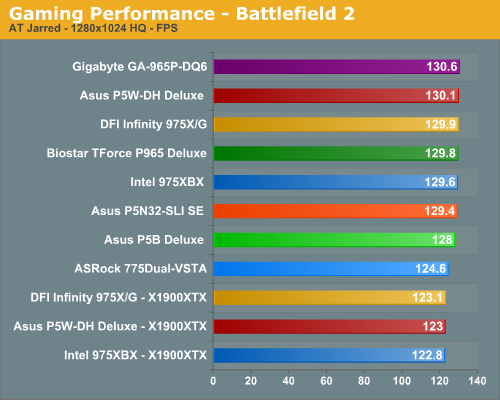
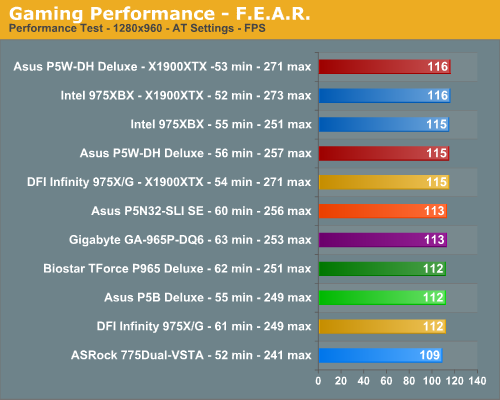
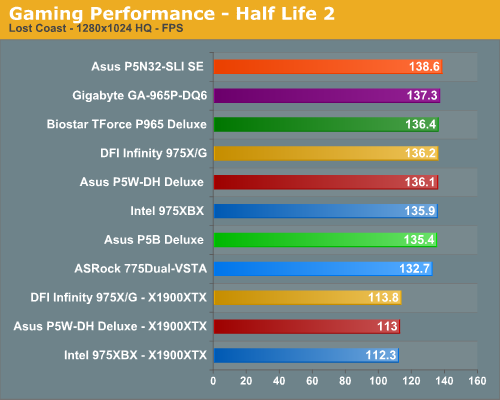
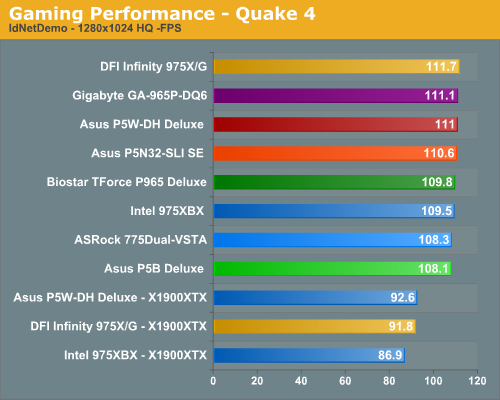
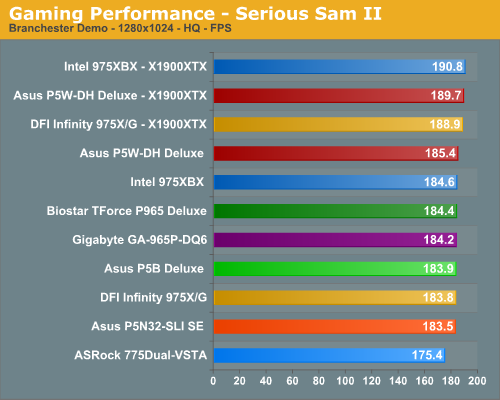
The two most performance oriented boards in our roundup are the ASUS P5W-DH and Gigabyte GA-965P-DQ6 boards, and they complete our gaming benchmarks with scores at or near the top of each game category. The most consistent board in the roundup is the Biostar TForce P965 Deluxe that stayed the course throughout testing by remaining in the middle sector of the group. Although the Biostar board did not finish first, it also did not have swings where it was at the top of one benchmark and near the bottom on another one. The ASRock board finished last among the 7900GTX boards four times and second to last on the Quake 4 test where it had its best showing. Overall, the scores generated by this group of boards are so close that you would be hard pressed to actually see or feel the difference in real game play.
The ATI X1900XTX cards finished significantly behind the NVIDIA cards in Half Life 2: Lost Coast where they generally score even or ahead of NVIDIA depending upon game settings. While their performance in the DOOM 3 engine games are normally several percentage points behind the NVIDIA based cards until recently, the difference in our Quake 4 test is also perplexing with the current 6.6 driver release. We ran our ATI X1900XTX in the ASUS P5N32-SLI board and the percentage differences between the GPUs were the same that we see on the AMD S939 or AM2 platforms. It appears to us at this time there is an ATI driver bug with the current Intel chipsets and Core 2 Duo, or perhaps a lack of optimization.
We tested with a small group of games due to time constraints, but we picked games based on a variety of game engines to give a quick indication of the boards' performance. Additional testing will be done in our full board reviews but for this roundup we are using Serious Sam 2, Half Life 2: Lost Coast, F.E.A.R, Quake 4, and Battlefield 2. All boards were tested with the EVGA 7900GTX using NVIDIA 91.31 WHQL drivers. The Intel 975X boards were also tested with a single ATI X1900XTX card with the Catalyst 6.6 driver.





The two most performance oriented boards in our roundup are the ASUS P5W-DH and Gigabyte GA-965P-DQ6 boards, and they complete our gaming benchmarks with scores at or near the top of each game category. The most consistent board in the roundup is the Biostar TForce P965 Deluxe that stayed the course throughout testing by remaining in the middle sector of the group. Although the Biostar board did not finish first, it also did not have swings where it was at the top of one benchmark and near the bottom on another one. The ASRock board finished last among the 7900GTX boards four times and second to last on the Quake 4 test where it had its best showing. Overall, the scores generated by this group of boards are so close that you would be hard pressed to actually see or feel the difference in real game play.
The ATI X1900XTX cards finished significantly behind the NVIDIA cards in Half Life 2: Lost Coast where they generally score even or ahead of NVIDIA depending upon game settings. While their performance in the DOOM 3 engine games are normally several percentage points behind the NVIDIA based cards until recently, the difference in our Quake 4 test is also perplexing with the current 6.6 driver release. We ran our ATI X1900XTX in the ASUS P5N32-SLI board and the percentage differences between the GPUs were the same that we see on the AMD S939 or AM2 platforms. It appears to us at this time there is an ATI driver bug with the current Intel chipsets and Core 2 Duo, or perhaps a lack of optimization.










123 Comments
View All Comments
Gary Key - Thursday, July 20, 2006 - link
Thank you for the comments. Our focus on the first cooler roundup will be on units that cost under $25 but the Tuniq will be included as a reference point along with the retail Intel unit. Our follow up will include the high end air coolers and some water cooling units.The Tuniq is considered to be one of the best air coolers available at this time although we are starting to see this design being incorporated by other suppliers quickly.
biggersteve - Tuesday, September 19, 2006 - link
Hope you can get an Arctic Cooler Pro 7 into that cooler review. Quiet as a tomb and mighty cool.jonmcguffin - Thursday, July 20, 2006 - link
A feature built into the Core 2 Duo processors is this new Digital Thermal Sensor that supposedly has the ability to provide much quicker and more accurate thermal information about each processor. The key with this though is that it requires support from the motherboard. Why did you guys not mention this feature in any of the motherboards you tested?My guess is that since the P965 was "built" for Core 2 Duo, my guess would be that it supports this feature while the older 975 does not. In going back and forth between pro's and con's of the P965, if this feature is in fact built into the chipset/motherboard, it is worth pointing out. I'm not really an overclocker though I do want to buy a system that will be rock solid in stability for many years to come. Quite PC's that are very reliable and stable are critical and this is a good feature.
Also, you reviewed the Abit AB9 Pro motherboard a few weeks back but somehow it was left out of this overview. At $160 on the street, despite it's layout issue's, this looks to me like perhaps the best board right now for the guy who isn't rich and just wants a very solid Core 2 Duo mobo.
Hope you get a chance to review and respond.
Jon
Gary Key - Thursday, July 20, 2006 - link
Jon,The Gigabyte DQ6 actually has the ability to select readings from either sensor (Digital/Legacy) on the CPU in the power management settings. We will go over this in detail in our full review of the board or other Conroe capable boards in the future. These type of features along with audio and storage performance are not generally not reviewed in the guide articles but covered in the full product reviews.
The Abit AB9-Pro is shaping up to be a very good mid-range board (prices around $142 already) once the bios is complete. We are due to receive bios B6 next week that is optimized for Conroe and allows full memory configuration from both a timing and ratio viewpoint. The board was not ready to be included in the buyers guide until Abit had a final bios to us. We will report the results as soon as we complete testing.
Wesley Fink - Thursday, July 20, 2006 - link
We had planned to include the Abit AB9 in our roundup IF Abit got the memory issue fixed before the review. Unfortunately even the latest beta BIOS we received on Tuesday does not fix the issue. There is no means on the current Abit board to change memory speed or timings. It supposedly reads the SPD and boots at DDR2-533 5-5-5-15 with every dimm we tried. You can't run Value Ram at DDR2-800 for example or run DDR2-800 at rated speed. Or change timings to 3-2-3 at DDR-533 even if you know the ram can run at those timings. We did not think it fair to make a big deal of this in a review since Abit is supposedly working on it, but we see they are now also selling the board at some retailers and memory is still broken as far as we know.We consider this problem, if not fixed, to disqualify the Abit from consideration by any Enthusiast. We plan to do a full review of the Abit AB9 Pro if and when Abit fixes this major problem.
supremelaw - Thursday, July 20, 2006 - link
Jon,Why would more accurate thermal sensors
have high priority, if the Conroe runs
much cooler and more efficiently?
Are you planning extreme O/C, perhaps?
Wouldn't a superior HSF have higher priority?
e.g.:
http://www.supremelaw.org/systems/heatsinks/warnin...">http://www.supremelaw.org/systems/heatsinks/warnin...
Just curious here.
Sincerely yours,
/s/ Paul Andrew Mitchell
Webmaster, Supreme Law Library
http://www.supremelaw.org/">http://www.supremelaw.org/
falc0ne - Wednesday, July 19, 2006 - link
The usual best from Anandtech..I was in a bit of fog if switching to conroe or not, but now I have a mutch more clearer picture. After the part2 of this suite, it will all be clear to me.P.S. Your articles on Nvidia's NForce 4 platform made me choose that platform and AMD64.
My sincere thanks, I owe you a lot
wackypete - Wednesday, July 19, 2006 - link
Thanks for putting this article together. Your effort has not gone unnoticed.Howard - Wednesday, July 19, 2006 - link
Anybody know what chips it uses? The 5-5-5-15 DDR2-667 variety, that is.Gary Key - Wednesday, July 19, 2006 - link
We still have additional memory selections from a variety of suppliers arriving for further memory reviews at this time.